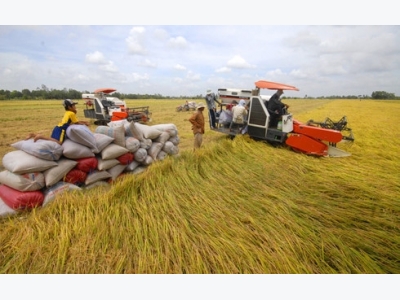Japan teaches Vietnamese how to grow high quality rice

Rice has been a staple food of Vietnam for more than a millennium but today the local country farmers and rice processors only produce strains that tend to be of very low to middling quality.
Currently, the government has designated one-half of the total land available for agriculture production, or 3.8 million hectares, for rice cultivation. About two-thirds of the rice produced is used domestically with the remaining one-third exported to foreign markets.
Due to the failure of Vietnamese rice to meet with strict quality control standards most of the rice is exported to China, a country which there are no food safety standards to speak of.
The quality of Vietnamese rice isn’t problematic just because it contains too many pesticides, it relates as much to the failure of local farmers to grow high-quality varieties such as jasmine rice.
Top supermarkets in countries like America or Japan quite simply will not put Vietnamese rice on their shelves because consumers in those markets demand high quality rice.
The primary problem that the rice segment in Vietnam suffers from is fragmentation and small-scale production, said Dr Nguyen Anh Phong, a researcher at the Centre for Agriculture Policy.
This leads to poor selection of varieties to plant to begin with and then is further compounded lack of knowledge of good agricultural practices leading to improper storing and milling that in turn causes degradation and excessive post-harvest losses.
And unlike modern day industrialized countries where mechanical dryers are used, Vietnamese farmers typically let the sun do the work, which monumentally contributes to post-harvest losses.
Phong added that most Vietnamese farmers are not good businesspersons and lack even a cursory understanding of contract law let alone foreign commerce and international taxation issues.
Most notably, they suffer from a total lack of understanding of other cultures and consumers buying habits and preferences.
However, the rice segment in Vietnam is evolving as more Japanese rice growers are entering and transitioning to larger farms with higher levels of technical expertise in growing higher quality rice with more sophisticated management skills.
Smaller antiquated Vietnamese farms are falling by the wayside, Phong underscored.
In addition, the Ministry of Agriculture and Rural Development is currently in discussions to shift low-productivity rice areas populated by small local Vietnamese rice farms to raising fish and seafood, he noted.
The major global destinations of intact-grain Jasmine rice are the following countries: China, Singapore, Malaysia, the US, Singapore, Hong Kong, Côte d’Ivoire and Japan.
The five largest rice importers in the world are China at 4.7 million metric tons annually, Nigeria at 2 million metric tons, Philippines at1.8 million metric tons, Iran at 1.6 million metric tons and Indonesia at 1.6 million metric tons per annum.
Parboiled and other common non-fragrant white rice are being exported to Middle Eastern and African countries primarily by Thailand and India. On the other hand, the Basmati rice trade is currently dominated by Pakistan and India, with their shipments’ destinations primarily being to Middle Eastern countries.
Ten years ago, Thailand was recognized as the dominant force in the Jasmine rice market but, in the most recent of years, Cambodia and Vietnam have both made important headways into the market, causing Thailand’s share in the Jasmine market to drop to less than 50%.
Currently, with the help of Japan, Vietnamese have claimed 40% of the global market share for Jasmine rice, making it the biggest competitor globally for Thai ‘Hommali’ Jasmine rice.
Related news
 Your next Kobe beef may come from Vietnam
Your next Kobe beef may come from Vietnam Vietnam has inked deals with Japanese businesses from Hyogo Prefecture to fast-forward investment in a Japanese-style cow farm in the province.
 Construction of Masan’s $44mn pig farm ceases in central Vietnam
Construction of Masan’s $44mn pig farm ceases in central Vietnam The pig farm developed by Masan Nutri – Farm Company, a Masan Group subsidiary, is being built in the north-central Vietnamese province of Nghe An
 Vietnamese consumers willing to pay more for safe foods: survey
Vietnamese consumers willing to pay more for safe foods: survey About four out of five Vietnamese consumers are willing to spend more on foods produced from materials that are labelled safe and environmentally friendly